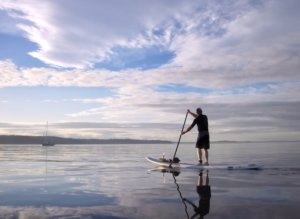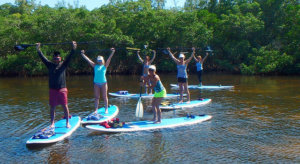Introduction To Kids Stand Up Paddle Board
Paddle Boarding with your kids is one of the most relaxing and enjoyable activities you can do as a family. Stand Up Paddle (sometimes called “SUP”) Boarding is simply either propelling yourself using your arms in a swimming type of motion or with a paddle, while you and your child are either kneeling, sitting, standing, or lying on top of a paddle board. This type of activity is normally done in the open waters of a lake, river or ocean. Originally, paddle boarders used this type of technique to travel between islands, or even to take a journey from one coast to another. Stand up paddle boarding (SUP), also known as stand up paddle surfing, has become increasingly popular with younger children. However, it takes a lot of practice and requires a person to build up some skill. Once a kid (or parent) has achieved the balance and the act of stand up paddle boarding, then they will be able to enjoy a fun, and a relaxing way to play on the water. This activity takes very minimal gear to for your kids to enjoy and is easy to learn. After reading this introductory guide on stand up paddleboarding, we hope you are encouraged to help your child learn the basics and get out on the water!
Stand Up Paddle Board Basics
When it comes to the designs of kids stand up paddleboards, there are certain elements and terms you need to know.
Basics of the Stand Up Paddle Board. The nose is the front part of the board that either planes over or breaks through the water. The deck is the upper portion that you stand, sit or lay on. The tail is the rear of the board. The fins go underneath the deck on the bottom of the board and provide stability and steering control.
Paddle Board Measurements. In general, the measurements for each kids paddle board is in feet and inches. Most board manufacturers will give you the height, width and thickness. Obviously, the wider and thicker a board is, the more stable it will be on the water. The trade-off is that you will lose maneuverability and speed on the water. The general rule for kids paddle boards, especially for beginners, is that the wider the board, the better!
Your Kids Measurements. To find the right paddle board, make sure that you know your child’s height and weight. We also ask that parent assess the physical ability of the child before purchasing one. The older the child, the larger the board they can handle in the water.
Hull Design. There are two basic types of paddle boards: planing hulls and displacement hulls. A planing hull sits on top of the water. It is generally wider, more stable and has more volume, and is better for kids who are beginner paddle board enthusiasts. Displacement hulls on the other hand, sit lower in the water and cut through the water like a ship. The benefit to a displacement hull is that they are generally faster on the water.
What Are You Using the Board For? Certain stand up paddle boards are specifically designed to handle certain types of paddle boarding conditions. A few questions to ask yourself before you begin: What type of location will you be in when you are paddle boarding? Am I going to have more than one person or child on the paddle board at one time? Do you want to use it as a long distance paddle board or just go a short distance? Are you looking for a more stable type of board or one that is more maneuverable? There are many different types of boards for specific paddling activities. If you are looking for a more stable board, then you would need to purchase a wider sized board. If you are wanting a more maneuverable one, then a more narrow board will be sufficient.
What You Need For Paddle Boarding
There are many different types of things that you will need when you are going to paddle board.
A Stand Up Paddle Board. The first thing you will need is, of course, the board itself. Determining the intended use of the board, and the size and the physical ability of the paddler, will determine which type to use. It will also depend on what activity you are planning to participate in with the paddle board, such as recreational, fitness, whitewater, surfing, racing, or flat-water.
A Paddle. When you are doing Stand Up Paddle Boarding with your kid, you will also need a paddle. A general rule is that you add 5-8 inches to the height of the participant. For example, a child who is 4 feet tall (48 inches tall) will need a paddle that is 53 to 56 inches in length. Paddles are made of wood, however, these types of paddles tend to be a bit heavier than the ones that are made out of aluminum, plastic or carbon fiber. It is prudent to try out a few paddles before you ultimately purchase one for your child.
Leash. An important piece of equipment that should be purchased, is a paddle board leash. It tethers the board to your leg, therefore, if you are to fall off of the board, you will be able to retrieve your board instead of it floating away.
Personal Flotation Device. Most places your kids paddleboard require a life vest. Regardless of the status of the law, we recommend that you keep a life vest on your child at all times.
How To Stand Up On A Paddleboard
When you are trying to stand up on your paddle board, you will need to make sure that you and your child are on calm and flat water, because you have to keep in mind that you could fall off and if the water is not still you will have trouble getting back onto your board and standing up. It is hard to stand up in the beginning so it will be a good idea to wear a swimsuit or a wetsuit when you are starting out. When you are ready to stand up on your paddle board, make sure that your board is out in the water so that the fin on the board does not drag on the bottom. Start out on your knees and take a few strokes on each side of the board, then slowly stand up with one foot at a time and stay in the middle of the board with your feet shoulder width apart, and then keep a slight bend at the knees and your core centered over the board.
Basic Stance Techniques For Kids on the SUP

When it comes to any type of new sport that your child is starting out with, it is always important to learn the proper techniques.Many kid’s first instinct is to keep their feet parallel and hip width apart on top of the board. However, we recommend you instruct them to have one foot slightly in front of the other. This will ensure the best base on top of the board when they attempt to paddle.
Basic Kids Paddle Board Strokes
There are a few basic strokes that kids will be required for you to perform when you are paddle boarding.
Forward Stroke. This is the most basic stroke that will propel them forward. While standing or kneeling, have your child keep the bottom part of their arm straight and still, extend the paddle forward, rotate their top shoulder forward and extend their reach to a comfortable distance. Insert the paddle into the water and bury it under the water, and then pull the paddle through the water next to their body approximately two to three inches from the paddle board. To be able to stay in a straight line, it is prudent to remember to switch to the other side of your body after you have done a few strokes. Repeat this on each side.
Sweep Stroke. The side stroke is the most basic way to turn your board around, and is very easy to master. You can start at the nose or tail of the board. Start with the paddle close to the board and push out. Tell your kids to imagine they are sweeping dust away from the edge of the board. You will need to slide your paddle into the water and use short and quick strokes on one side of your board. This will turn the boat around so that you are able to head off into the opposite direction.
Reverse Sweep Stroke. This is the opposite of the forward stroke; instead of starting in front of your kid’s body and pulling toward them, you will start with the paddle in the water by your hip and push forward. This will assist your child in stopping or slowing down the SUP.
Basic SUP Strokes
The steps you will want to follow are easy and basic. You will always want to make sure that whenever you are beginning to start a stroking motion, that you reach as far as your arm can to achieve the distance you need. Whenever you are pushing the blade of the paddle into the water, make sure to use your whole body to do this, and to make sure that you push the blade in deep, and do not want to pull the blade out too far behind your body. Make sure that you pull the paddle out before it gets too far behind you, or you may have trouble balancing and then falling into the water, and you will want to make sure and do it the same way when you are bringing the paddle back up to the front. At the end of each individual stroke, you should always take a short break to be able to relax your muscles.
Avoiding Hazards
When you are participating in paddle boarding, it is important for you to be aware of the possible hazards that can obstruct your path. These hazards can include:
- Boats
- Other paddle boarders
- Personal watercrafts
- High winds
- Natural hazards like stumps or trees in the water
- Sandbars
- Weather
